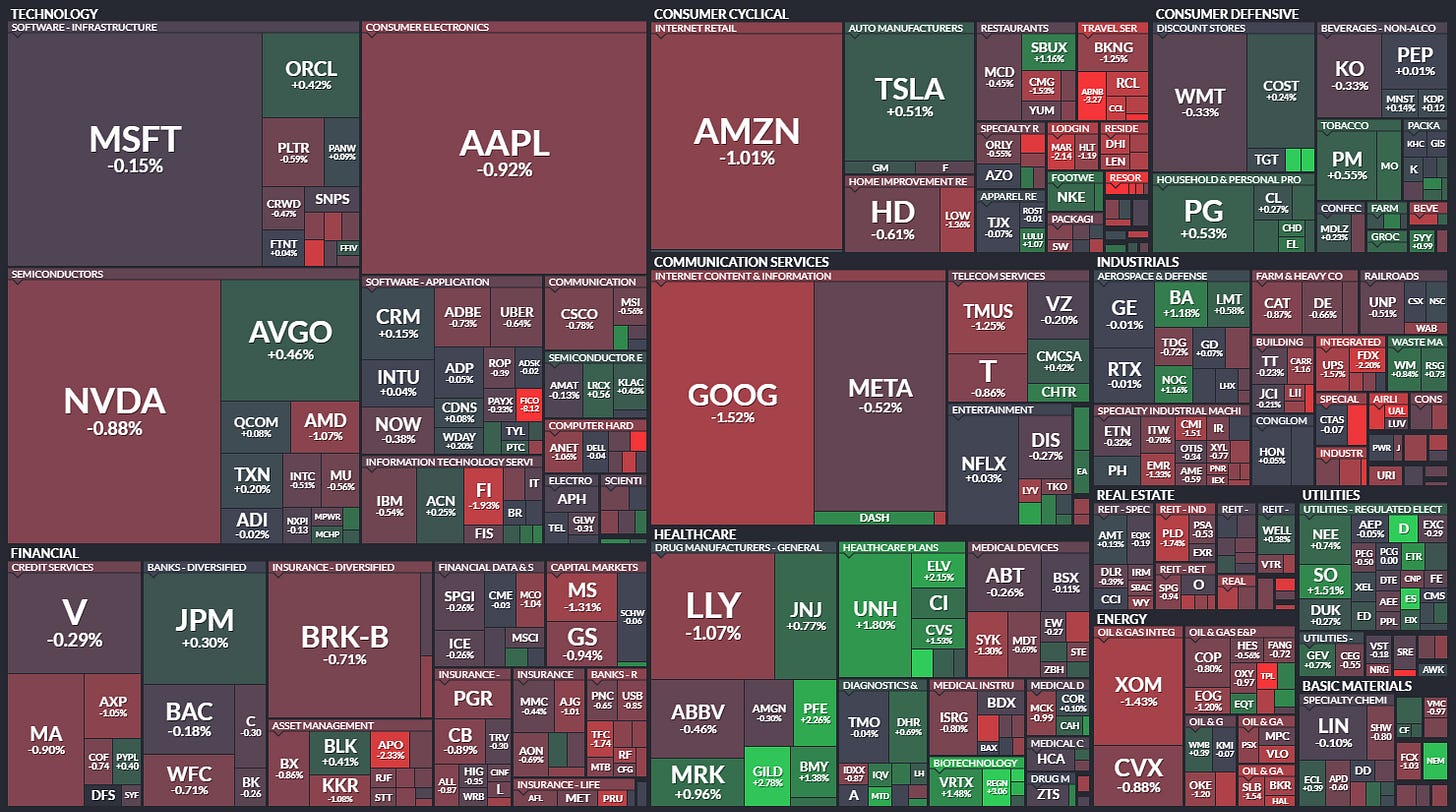After six consecutive sessions of growth, U.S. stock indices took a breather. The S&P 500 ended the day down 0.39%, joined by declines in the Dow Jones (-0.27%) and Nasdaq 100 (-0.37%). Investors seemed to pause and digest recent gains while reacting to rising signals of uncertainty from the Fed, the economy, and global politics.
Overall Market Picture
The day was relatively quiet in terms of macroeconomic and corporate news. Market breadth pointed to bearish sentiment, with declining stocks outnumbering advancers by 8 to 5 on the NYSE and 11 to 10 on the Nasdaq. The energy sector led the losses, dropping 1.0%, while defensive buying supported utilities, healthcare, and consumer staples.
Futures followed suit: E-mini S&P fell 0.44%, and Nasdaq futures dropped 0.45%. Driving the selloff were rising 10-year Treasury yields, now at 4.48%, and lingering concerns over trade policies and Moody’s recent downgrade of the U.S. credit rating.
Politics and the Fed: “Wait and See” Mode
Comments from Federal Reserve officials added to market caution. Fed Vice Chair Jefferson and New York Fed President Williams both emphasized the need for more data before making rate decisions. St. Louis Fed President Musalem warned that tariffs would likely slow the economy and weaken the labor market. Currently, markets assign just a 5% probability of a rate cut in June.
Meanwhile, President Trump visited Capitol Hill to garner support for his economic agenda, but neither side appeared willing to compromise. Investors are now turning their attention to the G7 finance ministers' meeting in Canada and upcoming labor, manufacturing, and housing data later this week.
Earnings Season: Record Beats Amid Lowered Expectations
With over 85% of S&P 500 companies having reported Q1 results, 77% have exceeded expectations — the highest beat rate since Q2 2024. Earnings growth stands at +13.1%, well above the +6.6% expected before the season began. However, full-year 2025 earnings forecasts have been revised downward to +9.4% from +12.5% in early January, reflecting a cautious outlook for the second half of the year.
Selling Pressure: From Chips to Cruises
Several sectors came under significant pressure. Semiconductor stocks like Nvidia, AMD, and Marvell Technology lost 1% to 2% amid profit-taking. Cruise lines and casino operators also declined sharply — Norwegian Cruise Line and Las Vegas Sands fell over 3%.
Airbnb was the worst performer in the Nasdaq 100 after reports that the Spanish government ordered the removal of nearly 66,000 listings. AES dropped 4% after a downgrade from Jefferies, while Trip.com and Viking Holdings fell more than 5% each following weak quarterly results.
Winners Stand Out
Despite the broad selloff, several names shined. Moderna surged over 6% after favorable FDA news. Amer Sports jumped 18% on strong revenue and a raised full-year forecast. Dollar Tree, Pegasystems, Pfizer, and Deckers Outdoor also posted gains after positive analyst revisions or improved guidance.
International Outlook
Global markets were modestly positive on Tuesday. Euro Stoxx 50 rose 0.51%, China’s Shanghai Composite gained 0.38%, and Japan’s Nikkei added 0.08%. Meanwhile, yields on German and UK government bonds moved higher.
On the monetary front, ECB officials struck a cautious tone. Although a rate cut in June is possible, no clear signals have been given. Markets currently price in a 95% chance of a 25-basis-point cut at the June 5 ECB meeting.
The market has entered a holding pattern. Following strong earnings-driven momentum, investors are turning cautious. Rising yields, geopolitical risks, uncertainty around Fed policy, and political gridlock all suggest that consolidation may continue in the near term.
Key events this week include jobless claims, manufacturing activity, and housing data — along with any surprises from the G7 summit. Unexpected developments could quickly disrupt this fragile balance.




